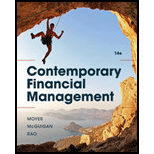
a)
To define: Risk
a)
Explanation of Solution
Risk is nothing but the probability of any adverse occurrence of an event. In finance, risk is the probability that an investment will yield real returns or cash flows less than expected.
b)
To define: Probability distribution.
b)
Explanation of Solution
Probability distribution describes the approximate probability of each of one or more possible outcomes.
c)
To define: Standard deviation.
c)
Explanation of Solution
Standard deviation is a statistical measure of a variable’s dispersion over mean. It is an absolute risk metric, which is defined as the square root of the weighted average square deviations from the mean of individual observations.
d)
To define: Required
d)
Explanation of Solution
Required rate of
e)
To define: Coefficient of variation.
e)
Explanation of Solution
Coefficient of variance is a measure of the inherent risk. It is defined as the ratio of any variable’s standard deviation to the mean.
f)
To define: Efficient portfolio.
f)
Explanation of Solution
A portfolio is efficient if there is no other portfolio with a greater expected return for a given standard deviation, or if there is no other portfolio with a smaller deviation for a given expected return.
g)
To define: Efficient frontier.
g)
Explanation of Solution
Efficient frontier consists of an optimal portfolio collection.
h)
To define: Capital market line.
h)
Explanation of Solution
Capital market line is a line which joins the risk-free rate and the portfolio of stocks. This shows the probability and projected returns that can be obtained by investing in probability-free investment and the stock portfolio of risky assets in different proportions of one’s wealth.
i)
To define: Beta coefficient.
i)
Explanation of Solution
Beta is one indicator of an asset or security’s systematic risk. It is nothing but the ratio of the
j)
To define:
j)
Explanation of Solution
CAPM is the Capital Asset Pricing Model, a principle that defines the risk and required return on securities and other assets.
k)
To define: Correlation coefficient.
k)
Explanation of Solution
Correlation coefficient is a general statistical measure of the degree to which two sets of numbers appear to shift or differ together, such as the returns from two securities.
l)
To define: Portfolio.
l)
Explanation of Solution
Portfolio is nothing but a series of two or more securities or assets.
m)
To define: Characteristic line.
m)
Explanation of Solution
Characteristic line is a line of regression that compares the periodic returns on holding periods on a given security to the periodic returns on the stock portfolio.
n)
To define: Security market line.
n)
Explanation of Solution
Security market line describes the relationship between systematic risk and the returns expected for individual securities.
o)
To define: Covariance.
o)
Explanation of Solution
Covariance is an absolute statistical measure of the degree to which two series of numbers appear to travel together or differ.
p)
To define: Systematic risk.
p)
Explanation of Solution
Systematic risk is the portion of the volatility in the return of a security that is caused by conditions that influence the entire market. It is also called as non-diversifiable risk.
q)
To define: Unsystematic risk.
q)
Explanation of Solution
Unsystematic risks are the threats specific to an organization. These risks are also called as diversifiable risks.
Want to see more full solutions like this?
Chapter 8 Solutions
Contemporary Financial Management, Loose-leaf Version
 EBK CONTEMPORARY FINANCIAL MANAGEMENTFinanceISBN:9781337514835Author:MOYERPublisher:CENGAGE LEARNING - CONSIGNMENT
EBK CONTEMPORARY FINANCIAL MANAGEMENTFinanceISBN:9781337514835Author:MOYERPublisher:CENGAGE LEARNING - CONSIGNMENT Intermediate Financial Management (MindTap Course...FinanceISBN:9781337395083Author:Eugene F. Brigham, Phillip R. DavesPublisher:Cengage Learning
Intermediate Financial Management (MindTap Course...FinanceISBN:9781337395083Author:Eugene F. Brigham, Phillip R. DavesPublisher:Cengage Learning


